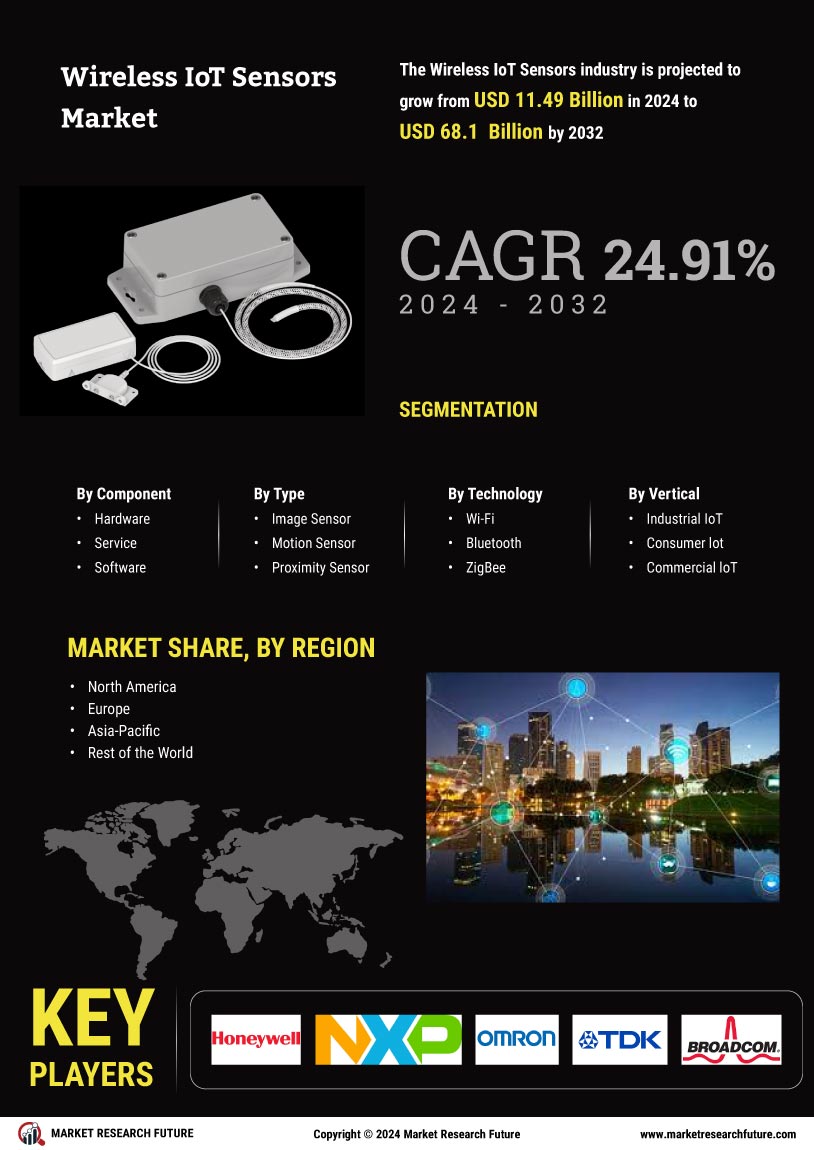Market Growth Projections
The Global Wireless IoT Sensors Market Industry is poised for substantial growth, with projections indicating a market size of 11.5 USD Billion in 2024 and an anticipated increase to 132.7 USD Billion by 2035. This growth trajectory reflects a compound annual growth rate (CAGR) of 24.91% from 2025 to 2035. The increasing integration of IoT sensors across various sectors, including smart cities, industrial applications, and healthcare, underscores the market's potential. As organizations continue to recognize the value of real-time data and connectivity, the demand for wireless IoT sensors is expected to surge, shaping the future landscape of the industry.
Rising Demand for Smart Cities
The increasing global emphasis on smart city initiatives drives the Global Wireless IoT Sensors Market Industry. As urban populations grow, cities are adopting IoT technologies to enhance efficiency and sustainability. For instance, cities are deploying wireless sensors for traffic management, waste management, and energy efficiency. This trend is projected to contribute to the market's growth, with the industry expected to reach 11.5 USD Billion in 2024. The integration of IoT sensors in urban infrastructure not only improves service delivery but also fosters a more connected urban environment, indicating a robust demand for wireless IoT solutions.
Advancements in Sensor Technology
Technological advancements in sensor capabilities significantly influence the Global Wireless IoT Sensors Market Industry. Innovations such as miniaturization, enhanced battery life, and improved data processing capabilities enable the development of more efficient and versatile sensors. For example, the emergence of low-power wide-area networks (LPWAN) allows for long-range communication with minimal energy consumption. These advancements are likely to attract investments and drive adoption across various sectors, including healthcare, agriculture, and manufacturing. As a result, the market is anticipated to grow substantially, potentially reaching 132.7 USD Billion by 2035.
Growing Adoption of Wearable Technology
The rising adoption of wearable technology is influencing the Global Wireless IoT Sensors Market Industry. Wearables equipped with wireless sensors are increasingly utilized in healthcare for monitoring vital signs, physical activity, and overall health. This trend is particularly evident in the growing demand for remote patient monitoring solutions, which enhance healthcare delivery and patient outcomes. As the healthcare sector embraces IoT solutions, the market for wireless sensors is expected to expand significantly. The convergence of healthcare and technology suggests a promising future for wireless IoT sensors, with potential applications extending beyond traditional healthcare settings.
Expansion of Industrial IoT Applications
The expansion of Industrial IoT (IIoT) applications is a crucial driver of the Global Wireless IoT Sensors Market Industry. Industries such as manufacturing, logistics, and energy are increasingly adopting wireless sensors to optimize operations, enhance productivity, and reduce costs. For example, predictive maintenance enabled by IoT sensors can significantly minimize downtime and improve operational efficiency. This trend is likely to contribute to a compound annual growth rate (CAGR) of 24.91% from 2025 to 2035, reflecting the growing reliance on IoT technologies in industrial settings. The integration of wireless sensors in industrial processes underscores the transformative potential of IoT.
Increased Focus on Environmental Monitoring
The growing awareness of environmental issues propels the Global Wireless IoT Sensors Market Industry forward. Governments and organizations are increasingly utilizing wireless IoT sensors for environmental monitoring, including air quality, water quality, and climate change tracking. For instance, sensors deployed in urban areas can provide real-time data on pollution levels, enabling timely interventions. This heightened focus on sustainability and environmental protection is expected to drive market growth, as stakeholders seek to leverage IoT technology to address pressing environmental challenges. The industry's expansion is indicative of a broader commitment to sustainable development.
















Leave a Comment